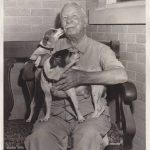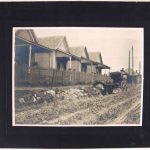Foundation History
Hall-Voyer Foundation
Honey Grove, Texas
The private non-profit foundation now known as the Hall-Voyer Foundation was granted its charter April 15, 1940. It was chartered as the David Graham Hall Trust and David Graham Hall Foundation. The trust supported the Foundation. In 1984 the name was changed to the Hall-Voyer Foundation to honor Richard F. Voyer, who was responsible for guiding and building the Foundation since its organization.
There are not very many Foundations as old as the Hall-Voyer Foundation. It has grown and changed keeping up with the times and the needs of the people it serves. From its inception in Dallas, then its move to Monkstown and finally to Honey Grove, it has touched the lives of many thousands of people in various ways.
The “Dallas Morning News” dated May 27, 1940 had an article about the establishment of the Foundation. Dr. David Graham Hall, who was 82 years old at that time, turned over $300,000 worth of real estate to set up the new Foundation. This was from a man who never made over $3,000 a year. The Foundation’s purpose was for treatment and prevention of communicable diseases, primarily venereal disease, and to promote ways to accomplish this.
David Graham Hall was born in 1858 in New Hampshire. Dr. Hall was an obscure physician, so publicity shy that even other Dallas doctors did not know him. The article stated in 1890 he used typhoid shots in Dallas for the first time and was threatened with hanging. He was widely known as the “Squirt Gun Doctor” or “Shooting Doctor” because of the large hypodermic syringes he used. From that time he lived literally hidden from public notice in the middle of downtown Dallas. He was the first Harvard Medical School graduate to practice medicine in Dallas.
Richard F. Voyer was a self-made man who ran away from a foster home in Massachusetts when he was 13 years old. He made his way to Texas and later became an attorney. He set up the Texas Social Hygiene Association in Austin in 1939 for the purpose of prevention and control of venereal disease, and to lobby for better public health in Texas. He heard about Dr. Hall’s desire to set up a Foundation, and went to him with a proposal for the David Graham Hall Foundation. Mr. Voyer was President and Executive Director of the Foundation until his death in 1989.
The first trustees of the David Graham Hall Trust were Karl Hoblitzelle, B. F. McClain, Carr Collins, and Homer R. Mitchell.

Dr. David Graham Hall (circ 1940’s)
In 1973. the DG Hall Trust articles of incorporation were amended. The purpose of the Trust became the establishment and operation of libraries, museums, auditoriums, civic centers, educational facilities, human relations programs and to promote or support communital health and social welfare programs for the people of Texas. In 1984 the Trust was dissolved and the Hall-Voyer Foundation took over the assets. Through the years the property in Dallas that was given to start the Foundation was sold and the funds invested in stocks and bonds. The Foundation operates from the income from these investments.
The Hall-Voyer Foundation is an operating foundation. Operating foundations must operate their own programs, instead of giving the funds to other non-profits for their programs. An operating foundation must spend eighty-five percent of their income each year for programs that they control.
The Foundation started with little actual revenue, just the rents from the properties owned. Most of the properties were small “shotgun” type houses in the Hallsville section of Dallas. At that time the streets were dirt. One of the houses still survives today and may be seen in Old City Park in Dallas.

Dr. Hall’s “shotgun” rent houses in Dallas.
The early projects of the Foundation focused on blood tests for venereal diseases, mainly syphilis, and primarily for those above indigent levels of income, as 95% of all venereal disease control at that time was aimed at the indigent. The foundation set up a modern lab in Highland Park and sponsored free blood tests through people’s physicians. Tests were available to anyone.
The Hall-Voyer Foundation set up a free clinic in the Hall Street area. The Foundation served the armed forces during World War II, and received many letters of commendation. A working relationship was set up with Temple Lumber Company and a clinic was put in place at Pineland, Texas. Mr. Voyer and the Foundation directors lobbied the legislature for better public health laws, leading to the law requiring blood tests before marriage being passed. The advent of penicillin eradicated most of the venereal disease at that time and forced the Foundation to change its focus.
Some areas in which the Foundation became interested were the promotion of fluoridation of public drinking water supplies, the Dallas Health Museum, and operation of a Health Information Clearinghouse.
In 1960, the Foundation moved to Monkstown, Texas. Mr. Voyer was looking for a low income county that did not have a public health service and Fannin County fit that profile. While at Monkstown the Foundation set up the Monkstown Community Center, a ball field, youth programs, movies, socials, trips to the Texas State Fair for the community on a chartered bus, and rabies vaccination clinics. Lectures on public health were given by noted lecturers.
The Fannin County Commissioners court commissioned the Foundation to conduct a public health survey. Dr. Ira Hiscock, Professor of Public Health at Yale University headed the survey. This survey led to the construction of the Fannin County Hospital, which opened in 1972.
Honey Grove City officials and Chamber of Commerce leaders had taken notice of what the Foundation was doing in the county and approached Mr. Voyer with the idea of the Foundation coming to Honey Grove. They wanted to halt the deterioration of the downtown square and try to bring in more businesses. In 1961 the Foundation headquarters were moved to Honey Grove. Mr. Voyer purchased and restored a beautiful two story home on East Main Street and he and his wife moved there.
Some of the Foundation accomplishments in Honey Grove have been the renovation of many downtown buildings.
One of the renovated buildings was dedicated as the Civic Center. Its dedication was held on July 4, 1963, with Congressman Ray Roberts as principal speaker. The Center was composed of a modern banquet room and meeting rooms. In 1984, when the school system needed room for the kindergarten, the Foundation deeded the Civic Center and meeting rooms to the Honey Grove Independent School District. Upon completion of the new Honey Grove Campus, the School District returned ownership of the buildings to the Foundation.
Bertha Voyer started the library in 1962 in the former Evans Grocery store building, and it moved across the street in 1963 into its present location. Mrs. Voyer was known as the “Library Lady,” to many patrons and was loved for her sweet and gentle nature. The library was originally named the Honey Grove Public Library, but the name was changed to the Bertha Voyer Memorial Library after her death in 1985. The name was changed to the Honey Grove Library & Learning Center in 2018.
In 1985, the library became a member of the Texas State Library and Archives. The library is an accredited library with the State of Texas. For many years the City of Honey Grove contributed $2,500 annually to the library budget. That amount was increased to $6000 in 2024.
A Friends of the Library organization was started in 1985 and has been invaluable to the support and promotion of the library programs and activities. They assist with exhibits, programming, public relations, and fund raising.
The library is a focal point of the downtown area. Meeting rooms are available to non-profit and Civic Organizations as well as to members of the community.

